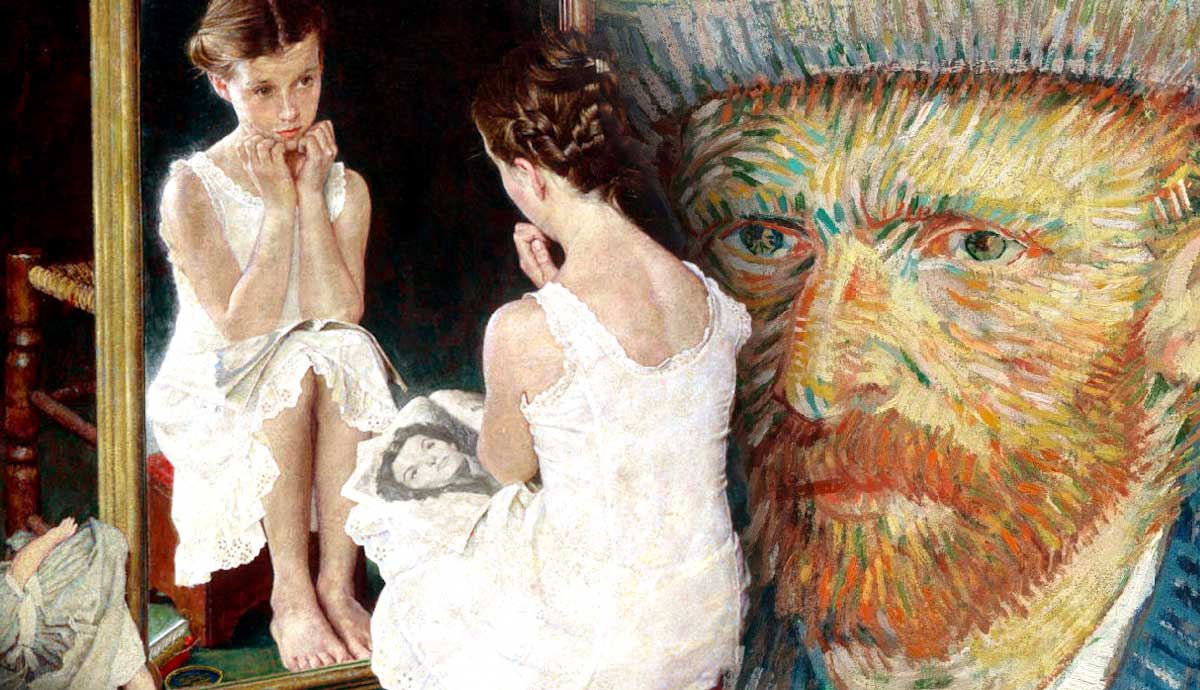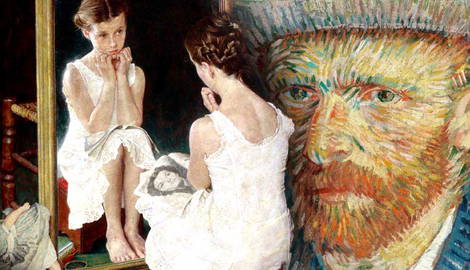
George Horton Cooley was one of the first sociologists to understand how deeply we are affected by others in our self-perception. What we think of ourselves is directly tied to how others see us, or rather by how we think they see us. Cooley suggested that other people act like a looking-glass for our Self-Image. Today, we know that he was right in his intuition. But how does this process work exactly? And what does it entail for our everyday lives?
Self-Image and the Looking-Glass Self in George Horton Cooley’s Work

Usually, when we think about Self-Image, we think about something that originates in ourselves. After all, that’s why it’s called Self-Image: it’s how we view ourselves, what we think about ourselves, and so on. Even though this is true, Self-Image is heavily influenced by what’s happening around us, especially by other people.
Let’s think about it. How many of the things that we say about ourselves are based on something we heard someone else say about us? Let’s think about how we are perceived by every person we know. Truth be told, we can be sure that every person we know has a different vision of us based on their personal experience.
This phenomenon is masterfully depicted in novel form by Luigi Pirandello, an Italian dramatist and poet who received the Nobel Prize in Literature in 1932. Some of his farces are rightfully considered precursors to the Theatre of the Absurd (facing the meaninglessness of the world became most important for Western culture, as we can also see in Albert Camus’ work).

Many of Pirandello’s novels deal with the theme of identity, but we want to take a look at one of his most-known works, which is “One, No One and One Hundred Thousand.” The protagonist, Vitangelo Moscarda, one day looks at himself in the mirror, and he starts to realize something he has never thought about before. Vitangelo Moscarda is not a single person. There are as many Vitangelo Moscarda as the people who know him.
His wife knows one version of Vitangelo Moscarda; each of his friends knows a different Vitangelo Moscarda, and so on. Vitangelo Moscarda is all of these personas but is also someone completely different at the same time. That’s where the title of the novel comes from: Vitangelo Moscarda is one, no one, and one hundred thousand personas.
What this tells us is that there are many versions of us, as they are perceived by every person we know. Even if the theme of identity was already explored in philosophy by authors such as David Hume, in the 20th century this became one of the most prominent fields of research both in philosophy and in psychology. George Horton Cooley studied this phenomenon from a different perspective, asking how our Self-Image is influenced by the reflection cast upon us by other people.
What other people think about me will have a direct influence on how I perceive myself. This is explained by Cooley through the Looking-Glass Self theory.
The Three Components of the Looking-Glass Self

Cooley introduced the Looking-Glass Self concept to explain how our Self-Image is (at least partially) a product of what other people think about us. This process has three stages.
In the first stage, we imagine how we must appear to others in social situations. Let’s make a quick and easy everyday life example. Let’s say I’m attending a work-related interview. I want to make a good impression, so I’m dressing up for the occasion, and I try to sound as confident as possible when I speak. In this first stage, I’m thinking about how I must appear to my could-be future boss. It doesn’t matter if my opinion about myself is positive or negative: at this stage, I’m just imagining how I must look to the other person, and there’s no judgment involved yet.
In the second stage, we imagine and react to what we feel the other person’s judgment is to said appearance. Looking back at our example, during my interview, I’m constantly checking how my interviewer is behaving. I try to study what he says, both verbally and non-verbally, to understand what he must think of me.

There’s something that should be underlined about this second stage. We don’t react to what the other person’s judgment is. We react to what we feel their judgment is. This is something completely different: I’m not reacting to what the other person is saying or doing (or not saying and doing) but to my interpretation of what they are saying or doing. Which, of course, is influenced by my background.
Let’s go back to our example. While I talk to my interviewer, I see that he sometimes nods his head. I could take this as a good sign: he must be liking what I’m saying. Of course, this could be true, but it could also be that the other person is nodding just as a personal habit.
In the third stage, we develop our sense of self and respond through this perceived judgment of others. Once again, let’s continue with our example. After seeing my interviewer nodding multiple times, I begin to think that I must be a good speaker. I think that I succeeded in being confident during my interview, so my Self-Image will reflect that going forward.
Of course, this process is not so streamlined in real life, as the process is much longer and much more complicated. Our Self-Image obviously cannot be easily shaped in the course of a single conversation. But in the end, this is basically what forms our Self-Image, at least according to Cooley.
Do Other People Shape Our Self-Image?

The purpose of the Looking-Glass Self concept is to explain our tendency to understand ourselves through the perception others have of us. Let’s go back to Pirandello’s Vitangelo Moscarda. What changes Vitangelo’s life is this exact realization. He finds it difficult to describe himself without using something that others would say about him.
Now, we should inquire further on this matter. Do other people shape our Self-Image? The answer is, of course, yes (this echoes what Sartre thought of the matter, to a certain degree). There are countless studies on this matter, and even if we don’t know if this process works exactly as Cooley described it, his theory is still an interesting take on what happens in social relations.
Today, we know that the way parents react to what their children say and do is very important. The child’s self-image is heavily reliant on their parent’s reactions. If a child is constantly scolded and yelled at, this will have a deeply negative effect on their Self-Image. It will take a long time before this scar can be healed while the child is growing up.
But other people influence our Self-Image throughout our lives, and not only during childhood. The more important we think a person is, the deeper the effect their view has on us. What we feel our parents think of us (if we have a good relationship with them, that is) will always have a greater impact on us than something said by a stranger. Every significant other will deeply affect our Self-Image in one way or another.
The Looking-Glass Self, Self-Image, and Self-esteem

The fact that we can influence people’s Self-Image so deeply leaves us with a great deal of responsibility towards others. Everything that we do and say has an impact on other people, especially those who are dearest to us. For the longest time, we did not give words and gestures the importance they have. We did not value enough how something we do or say can change how another person looks at themselves.
It should be clear from this that the Looking-Glass Self concept is tied not only to Self-Image but to Self-esteem as well. One person’s Self-esteem does not rely solely on his personality. Self-esteem is built over time and heavily depends on external support. If a person feels they’re getting a negative reflection from other people, they will probably build a negative view of themselves over time.
There are life stages at which people are much more sensitive to their peers’ judgment. We have already talked about children. Children’s Self-Image is heavily reliant on their parents’ reflections. To put it simply, children don’t know who they are yet. Try asking a child how they would describe themselves: they will probably answer using something that their parents or another significant adult have said in the past about them.
Another critical life stage is adolescence. At this point, the person’s Self is undergoing a dramatic change, abandoning who they were as kids and trying to make out who they will be as adults. If a person does not get positive feedback about who they are becoming during this age, this could potentially lead to serious emotional damage, which could, in turn, lead to social anxiety, depression, and more.

Parents still play an important role during a person’s adolescence, and they can still help out their children by providing positive feedback, but teenagers will most likely give their peers’ opinions more weight, thus giving them the power to shape their Self-Image. This is why teenagers strive so hard to be accepted by their peers: it’s crucial for shaping their Self-Image and Self-esteem.
Of course, we are making things seem a little more streamlined than they are in real life, but this is basically what happens to our Self-Image during our lives. We are constantly shaped by what other people think of us, whether we are aware of that or not.

And even if childhood and adolescence are probably the most delicate phases for building Self-Image, this process does not stop there. Throughout our lives, we are still subject to other people’s opinions, to what we feel they think of us. This will always affect our Self-Image, even during adulthood.
What we should conclude from this is that we play a crucial role in how the people around us see themselves. Our parents, our children, our partners, our friends, our colleagues, our neighbors, and so on are all affected by our vision of them. We should never underestimate what we can do to help a person in building a positive Self-Image (in terms of importance, we can add this lesson to what philosophy teaches us about love). This is ultimately the most important lesson that we can take from George Horton Cooley’s Looking-Glass Self.










